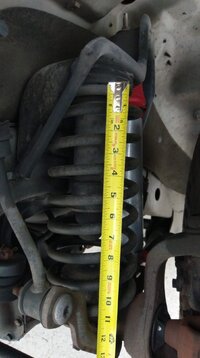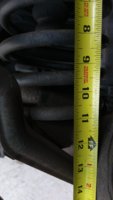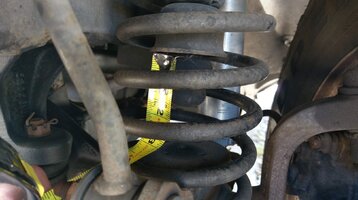I'm still getting to know my recently purchased 05 Sport, and at the risk of sounding like a total noob, I'm beginning to wonder if the stock front springs might be sagging. I read here that the stock front spring height is 12". I measure my front springs at 11" from the base to top of the spring, but excluding the isolator.
I'm sort of wondering if this might have something to do with the harsh ride I'm getting, even with the RS9000XL shocks that the PO installed.
For what it's worth, the rear springs are sitting at close enough to 8" that any difference is either negligible or measurement error.
Before I jump to conclusions, though, I have some questions.
Am I measuring the springs correctly?
The one and only PO used the Jeep as a DD for 125k miles. Would it be typical to see springs sag after that many miles?
The Jeep is currently not lifted, and although I'm thinking about a moderate lift at some point in the future, that's just not in the cards right now. Assuming it would be worthwhile to replace the front springs, are the Crown, OMIX-ADA and/or Moog springs acceptable replacements for stock springs?
Also, assuming I'm replacing springs, is there any other maintenance (not upgrades!) I should do while I have the wheels off and the front axle dropped? New isolators? Leveling spacers (ok maybe one upgrade) — or are those just for show?
Anything else in that area that I should double-check for repair/replacement at 125k miles while I'm in there?
I'm sort of wondering if this might have something to do with the harsh ride I'm getting, even with the RS9000XL shocks that the PO installed.
For what it's worth, the rear springs are sitting at close enough to 8" that any difference is either negligible or measurement error.
Before I jump to conclusions, though, I have some questions.
Am I measuring the springs correctly?
The one and only PO used the Jeep as a DD for 125k miles. Would it be typical to see springs sag after that many miles?
The Jeep is currently not lifted, and although I'm thinking about a moderate lift at some point in the future, that's just not in the cards right now. Assuming it would be worthwhile to replace the front springs, are the Crown, OMIX-ADA and/or Moog springs acceptable replacements for stock springs?
Also, assuming I'm replacing springs, is there any other maintenance (not upgrades!) I should do while I have the wheels off and the front axle dropped? New isolators? Leveling spacers (ok maybe one upgrade) — or are those just for show?
Anything else in that area that I should double-check for repair/replacement at 125k miles while I'm in there?




